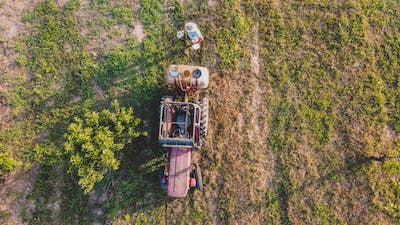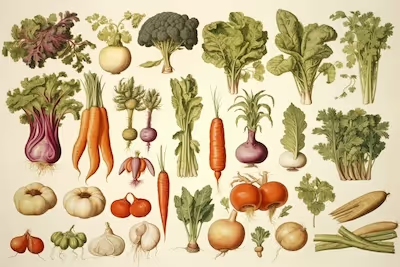Hydroponic Tower gardens: Grow More in Less Space, Year-Round

Hydroponic tower garden
Hydroponic tower garden systems save water, conserve space, and boost plant yields year-round. A hydroponic tower garden uses stacked vertical columns that deliver nutrients directly to plant roots, letting you grow lettuce, herbs, or strawberries almost anywhere. People with balconies or small patios can harvest crisp, clean produce without soil or mess. Discover how these space-saving towers bring fresh harvests right to your doorstep, no matter the season.
Cheatsheet: Vertical Veggies with Hydroponics
🌱 Benefits
- Grow up to 90% more in small spaces
- Save 95% water vs soil gardens
- No weeds, less pests, zero digging
- Harvest every 3-6 weeks (lettuce, herbs)
- Boost self-reliance, nutrition year-round
🛠️ Tools and Products You'll Need
- Vertical tower system (food-grade plastic or stainless steel)
- Hydroponic nutrient solution
- pH control kit
- Submersible pump
- Net pots + inert growing medium (coco coir, rockwool)
- Timer for pump
- LED grow lights (if indoors)
- Seeds or seedlings
📏 Setup Steps
- Assemble tower vertically; secure in low-wind, full-sun (outdoor) or bright well-lit (indoor) area
- Fill reservoir with clean water (68-72°F / 20-22°C); add nutrients (follow label)
- Adjust pH to 5.5–6.5 (test with kit)
- Set pump timer: 15 min on, 45 min off (adjust for crop)
- Plant seeds or seedlings in net pots with medium; place in tower slots
- Check water level/nutrients 1-2x per week; top up as needed
- Monitor for pests or root rot
- Harvest when mature; replant for continuous yield
🌞 Tips For Success
- Use filtered or rainwater for best plant growth
- Sanitize tower every 2-3 months to prevent algae buildup
- Rotate crops: leafy greens, herbs, strawberries excel
- Boost nutrients for fruiting plants
- Indoors: 14-16 hrs/day of full-spectrum LED light
🥗 Health & Nutrition
- Fresh produce retains 30%+ more vitamins
- No dirt = cleaner harvest, fewer contaminants
- Grow organic by choosing non-GMO seeds, OMRI nutrients
Hydroponic tower gardens: grow more in less space, year-round
I run towers on patios, rooftops, and a basement corner that used to store paint cans. They pay rent in basil, lettuce, and a constant hiss of water that sounds like a tiny creek.
What a Hydroponic tower garden is, in plain terms
Picture a vertical column stacked with plant sites, a reservoir at the base, and a small pump that lifts nutrient solution to the top. The water trickles or mists down over bare roots, then cycles back to the reservoir.
Aeroponic towers use fine mist and deliver high oxygen to roots. Drip and trickle towers use small emitters and a gentle cascade that is easier to maintain.
Why towers punch above their weight
Plants crave water, nutrients, oxygen, and light, and towers feed all of these without hauling soil. The vertical format turns a square foot into a ladder of harvests.
Hydroponics can cut water use by 70 to 95 percent compared to field production, according to UC Davis, FAO briefs on soilless culture, and NASA controlled-environment research.
In trials reported by land-grant universities, hydroponic leafy greens routinely yield multiple crop turns per year with tight spacing. My lettuce columns hit 4 to 6 times the output per square foot compared to the same footprint in raised beds.
Who these systems suit
Balcony growers who want clean produce without hauling soil or compost. Teachers running STEM projects on a cart, chefs with a line cook watering on breaks, and anyone chasing salad in February.
What grows best on a tower
- Leafy greens: butterhead, romaine, salanova, pak choi, and kale.
- Herbs: basil, mint, dill, cilantro, thyme, oregano, chives, and shiso.
- Fruiting, dwarf or compact: strawberries, cherry tomatoes, lunchbox peppers, cucumbers on a leash.
- Skip: carrots, beets, potatoes, big melons, and anything that needs deep media.
I nurse strawberries at kid eye level and let basil hog the sunniest slots. Heavy feeders sit lower where nutrient concentration runs a touch higher after recirculation.
Lights and environment that actually work
Outdoors, give towers 6 to 8 hours of sun and a windbreak to keep leaves from dehydrating. Indoors, aim for 200 to 300 PPFD for lettuce and 400 to 600 PPFD for fruiting crops, measured at the leaf surface.
Leafy greens like 60 to 70 F, 15 to 21 C, and fruiting crops like 68 to 78 F, 20 to 26 C. Keep humidity near 50 to 65 percent to balance growth and disease pressure.
Cornell CEA targets a DLI of 12 to 17 mol m−2 d−1 for lettuce, which you can hit with 12 to 16 hours under efficient LEDs.
Nutrients, EC, and pH cheat sheet
- pH: 5.8 to 6.3 suits most crops. I let it swing a little, plants like a gentle drift.
- EC for leafy greens: 1.2 to 1.8 mS/cm. EC for fruiting crops: 2.0 to 2.8 mS/cm.
- Use a complete hydroponic blend with Ca, Mg, and micronutrients. Folklore feeds plants stories, nutrients feed cells.
Municipal water with EC above 0.5 mS/cm drifts pH and adds hardness. A small carbon filter helps, and RO water removes the mystery entirely.
Daily and weekly rhythm that keeps towers humming
- Pump cycles: aeroponic towers 5 to 15 minutes on, 15 to 30 minutes off. Drip towers can run 24-7 at a low rate.
- Top off the reservoir daily with plain water, then adjust pH. Rebalance nutrients to target EC.
- Change the reservoir every 1 to 2 weeks, more often in heat. Stir, do not shake, when mixing nutrients.
Roots breathe as much as they drink, so avoid long flood times. I listen for the pump’s pitch, a cheap early warning siren.
Set up fast: my 30 minute method
- Assemble the column and rinse parts with 100 ppm chlorine solution, 0.25 teaspoon regular bleach per gallon, then rinse with clean water.
- Place the reservoir, fill with water, add nutrients to target EC, then set pH to 5.9.
- Install the pump and timer, confirm a steady return flow without splashing.
- Transplant healthy seedlings with 4 to 6 true leaves in net cups, tuck roots so they contact the stream.
- Run the first cycle continuous for 2 hours to hydrate roots, then switch to timer.
Seedlings win over direct seeding in towers. Strong starts prevent spindly regret.
Field notes from years of tower tinkering
Heat spikes wreck lettuce faster than aphids do. I move summer lettuce to shadier faces of the tower and run chilled water packs in July.
Tomatoes on towers thrive with a low EC, near 2.0, and more potassium during flowering. Keep one leader, prune the chaos, and tie gently with soft clips.
On a windy roof, I learned to add a simple guy line and a heavier base. Gravity plays by prison rules.
Troubleshooting quick fixes
- Pale new leaves, green veins: likely iron lockout. Lower pH to 5.8 and add a chelated Fe supplement.
- Brown leaf edges, high EC: dilute with plain water and recheck. Salt stress looks like sunburn.
- Wilting midday only: check pump timer and delivery lines for clogs. Algae film strangles tiny emitters.
- Leaf spotting in humid rooms: raise airflow, trim dense clusters, and sanitize with 2 to 3 percent hydrogen peroxide on plastic, not on leaves.
- Funky reservoir smell: change solution, scrub, and cover to block light. Biofilms love light leaks.
Cleaning and food safety that keeps produce pristine
Between crop cycles, soak plastic parts in 100 to 200 ppm chlorine or 3 percent hydrogen peroxide for 10 minutes. Rinse with clean water and dry before reassembly.
USDA guidance favors clean water, clean hands, and clean tools. I treat towers like a small kitchen station, everything has its place.
Buying guide and top picks by use case
Start with these specs: footprint, number of plant sites, pump flow, reservoir volume, and light coverage. Food-grade plastics and UV-stable parts outlive bargain gear.
- Aeroponic column systems, 20 to 36 sites, great for leafy greens and herbs. Fine mist speeds growth, but mist heads need periodic cleaning.
- Drip stackers with media cups, versatile and forgiving. Better for strawberries and small fruiting crops.
- DIY PVC towers with slotted net cup holes, lowest cost. Demands careful deburring and good filtration.
Brand examples many growers like include Tower Garden, Lettuce Grow Farmstand, Gardyn, Mr Stacky, and ZipGrow. I pick based on service parts, reservoir size, and whether lighting is integrated or modular.
What to ask before you buy
- How many heads of lettuce do you want weekly. Twenty sites can supply 6 to 10 heads if you harvest cut-and-come-again.
- Is lighting included, and what PPFD map does the maker publish. A single top light rarely covers lower tiers evenly.
- How easy is pump and line access. You will clean them, and you will want it quick.
- What filtration is built in. A simple mesh screen saves pumps from perlite and root hairs.
Indoor lighting, without the guesswork
For a 5 to 6 foot tower, I run four vertical LED bars, 100 to 240 watts total, 4000 to 6500 K spectrum. Leafy greens sit pretty at 12 to 16 hours daily, fruiting crops at 14 to 18 hours if you must push.
Measure PPFD at multiple heights. Lower tiers are always hungrier for photons.
Water, energy, and cost math
A 25 gallon, 95 liter reservoir usually lasts 1 to 2 weeks for greens, less in dry climates. Pumps draw 10 to 40 watts and run part time.
A 150 watt LED at 16 hours uses about 2.4 kWh per day, which is roughly 72 kWh per month. At 15 cents per kWh, that is about 10.80 dollars per month.
My small tower averages 2 to 3 pounds, 0.9 to 1.4 kg, of greens per week. At store prices of 8 to 12 dollars per pound for live basil or specialty lettuce, payback comes fast if you eat what you grow.
Indoor pollination and fruit set
Gently tap tomato clusters or use an electric toothbrush near the flower stem for vibration. Peppers self pollinate with a shake.
Strawberries do better with a small fan moving air across blooms. Bees help outdoors, and they do not send invoices.
Pest pressure and IPM in tight quarters
Scout twice weekly with a hand lens, then act small and early. Yellow cards catch fungus gnats, and a shop vac can thin aphids before you reach for oils.
University extensions recommend rotating modes of action and spot treating. I keep neem, insecticidal soap, and Beauveria bassiana on the shelf and start with the soap.
Alternatives and companions to a Hydroponic tower garden
- Kratky bins for lettuce, zero pumps, great for classrooms.
- Deep water culture buckets for tomatoes and peppers with air stones.
- Microgreens on racks for fast turnover and ridiculous flavor.
- Wicking beds outdoors for roots and tubers the tower will not host.
I pair a tower for leafy growth with a single DWC bucket for that one diva tomato. Balance keeps the kitchen interesting.
Advanced tweaks once you are hooked
- Inline filter and quick-disconnects for painless cleaning.
- Nutrient doser or peristaltic pumps for automated EC and pH control.
- Chiller loop for summer lettuce, 60 to 64 F, 16 to 18 C, in the reservoir.
- UV or ozone sterilization in recirculating systems with heavy plant counts.
Automation buys consistency. It also lets you leave town without bribing neighbors.
Anecdote that still makes me smile
One January in Denver, I clipped sun-warm strawberries from a tower under LEDs while snow stacked against the window. That tasted like cheating in the best possible way.
Credible sources I trust and quote
- UC Davis and UC ANR hydroponics publications on water savings, nutrient targets, and pH ranges.
- Cornell Controlled Environment Agriculture notes on DLI, lettuce lighting, and climate setpoints.
- FAO soilless culture briefs on efficiency and resource use in hydroponics.
- NASA controlled-environment crop research on resource use and LED lighting.
- UF IFAS greenhouse IPM guides for soft pest control strategies.
Grow clean, measure what matters, and let the tower do the heavy lifting. Plants repay precision with flavor.

Want smarter plant choices? 🪴
Frequently Asked Questions About Vertical Hydroponics Systems
How often should I check the nutrient solution and water levels?
Always monitor your nutrient solution and water reservoir at least every two or three days. Hotter conditions and fast-growing crops may require daily checks. Maintain the water level so the pump stays fully submerged and roots access consistent moisture. Replenish and balance the nutrient mix as needed to keep EC and pH stable.
What temperatures encourage healthy growth for most crops?
Maintain a consistent environment between 65 to 75 °F (18 to 24 °C) for most leafy greens and herbs. Fruiting plants prefer slightly warmer conditions up to 80 °F (27 °C) during the day. Large fluctuations or exposure to temperatures above 85 °F (29 °C) or below 55 °F (13 °C) can stunt growth or trigger stress.
How should I clean and sanitize the system between plantings?
Drain all nutrient solution and rinse components thoroughly with clean water. Use a diluted food-safe hydrogen peroxide or vinegar solution to scrub all surfaces, including pumps, growing tubes, and reservoirs. Rinse again with fresh water before the next planting cycle. Regular cleaning prevents algae, salt buildup, and diseases.
Can I grow root vegetables using this setup?
Most root crops, such as carrots and beets, require deeper growing media and horizontal space, which these vertical systems cannot provide. Focus on crops with shallow roots like lettuce, basil, arugula, and strawberries for best results.
Which lighting conditions work best, especially indoors?
Place units near south-facing windows for maximum sunlight when possible. For indoor growing, supplement with full-spectrum LED lights hung 12–18 inches (30–45 cm) above the highest plants. Provide 12–16 hours of bright, diffuse light each day to ensure robust growth and prevent leggy seedlings.
How do I prevent algae and pest issues?
Block light from reaching the reservoir by using opaque covers. Remove debris frequently and keep all surfaces dry on the exterior. Inspect plants for signs of pests weekly and rinse pests off with gentle water or insecticidal soap if infestations appear. Keeping humidity between 50–70% and strong airflow around plants discourages fungal and pest outbreaks.
Hydroponic tower garden brings fresh harvests to small spaces, letting flavor take center stage. These vertical systems thrive indoors or out, cutting mess and wasted water. With every level, you control the environment, tuning light, moisture and nutrients for peak growth. Experiment with new varieties and gadgets—see what’s possible here. The daily ritual shifts from digging in dirt to tending a living column of green. For hungry city dwellers or anyone short on time, a hydroponic tower garden delivers. If you want more ideas, the TAIM blog keeps the inspiration flowing. Grow smarter, eat better, and keep your hands on the future of food.
Pro-Level Tactics for Hydroponic Tower Gardens
Hydroponic towers deliver dense yields in compact spaces. With vertical systems, weekly harvests of baby greens or herbs peak at 14–18 ounces (400–500g) in 2.5 square feet (0.2 m2), using up to 95% less water than classic soil beds. Nutrient-dense plants develop quickly under strict control of root-zone conditions.
Optimize Your Nutrient Solution
- Rotate nutrient blends per growth phase. Use higher nitrogen for leafy starts, shift to potassium and phosphorus to trigger fruiting or flowering.
- Flush towers with clean water every 4–5 weeks to prevent salt buildup and root burn.
- Monitor EC (electrical conductivity) at 1.5–2.2 mS/cm for most leafy crops; 2.4 for fruiting plants.
Root Health Maintenance
- Keep reservoir temperature 64–70°F (18–21°C) for steady oxygen uptake. Warmer roots drop yield, cooler roots slow growth.
- Add beneficial microbes or mycorrhizae for organic systems—Trichoderma species boost resilience, Bacillus subtilis suppresses pathogens.
- Trim dead roots monthly; avoid overcrowding planting sockets to keep airflow strong.
Lighting for Tower Systems
- Position full-spectrum LEDs vertically; stagger towers to avoid shadowing.
- Use intensity of 200–300 μmol/m2/s PPFD for leafy greens. Fruiting crops require 350–400 μmol/m2/s.
- Run lights 14–16 hours daily for rapid cycles; reduce to 10–12 hours to slow growth and intensify flavors at harvest.
Closed-Loop Water Management
- Collect condensation and tower runoff, filter by activated carbon, and recycle to limit pathogens and extend nutrient life.
- Install a UV sterilizer or ozone generator for disease suppression in reservoirs.
- Track water evaporation; top off with reverse osmosis or rainwater for mineral control.
Nutrition Density and Culinary Quality
- Harvest microgreens at 7–10 days; vitamin C and polyphenol concentrations peak before true leaves form.
- Leafy greens in towers average 30–40% higher antioxidant content compared to open field counterparts due to rapid turnover.
- Apply gentle airflow (0.3–0.5 m/s) to toughen stems and boost essential oil formation in herbs.
Self-Sufficiency Power Moves
- Stack different species within the same tower for efficient polyculture—basil, lettuce, and strawberries grow well together.
- Rotate crops every 6–8 weeks to avoid pest buildup and nutrient exhaustion.
- Reserve the top tiers for shallow-rooted or heat-tolerant plants; reserve the lower, cooler sections for water-loving greens.
Find out which plants will thrive in your garden!
Answer a few fun questions and get custom plant recommendations perfect for your space. Let’s grow something amazing together!

start your season





